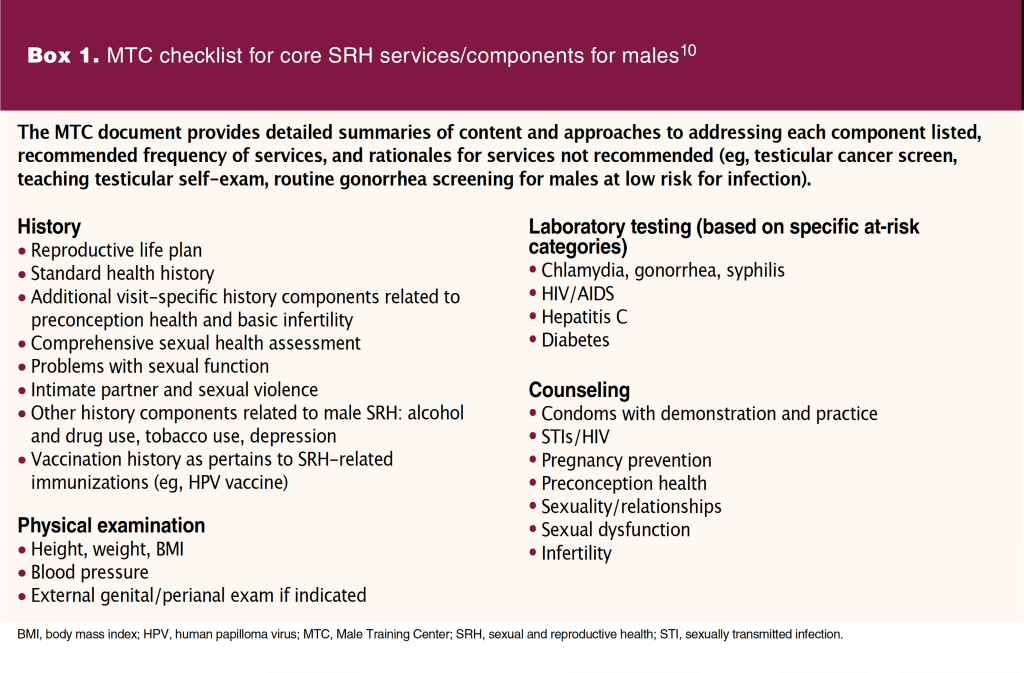Background
Providing SRH care for males requires attention to removing barriers and innovation to engage them in a variety of settings. Males, as they move into adolescence and young adulthood (and exit pediatric care), are less likely than their female counterparts to seek preventive healthcare that can include SRH services.4,5 A large proportion of young men do not know where to access SRH care.4,6,7 Even when adolescent or young adult males are seen in a healthcare setting, many healthcare providers (HCPs) do not address SRH.4,8,9 Evidence supports that if discussion about SRH with male patients does occur, it is often limited to how to decrease STI risk, and although males are willing to discuss SRH-related issues, they prefer the HCP initiate the discussion.7,9
Guidance for HCPs on the content and provision of SRH for males is often combined with recommendations for female SRH care. In 2017, the United States Office of Population Affairs (OPA) and the Centers for Disease Control and Prevention (CDC) reaffirmed and updated recommendations for providing quality family planning and related preventive healthcare that includes both female and male SRH services.2 Family planning services, as defined in this document, include reproductive life planning, contraception, preconception health, pregnancy testing and counseling, basic infertility services, and STI screening and treatment. Other important SRH care components include screening for reproductive cancers, providing appropriate immunizations, and providing or referring for prenatal and abortion care as needed.3 The audience for these recommendations extends beyond providers at sites dedicated to family planning services to providers in all primary care settings.
To support HCPs in providing male SRH services, the Male Training Center for Family Planning and Reproductive Health (MTC) remains the gold standard of male SRH assessment and elaborated on the OPA/CDC document with the publication of its report “Preventive Male Sexual and Reproductive Health Care: Recommendations for Clinical Practice.”10 The MTC document provides recommendations for eight health history components, three physical examination components, and six laboratory tests, as well as seven recommendations for counseling based on identification of risk.10 Box 1 outlines the MTC’s recommendations for SRH services for males.10 HCPs can find additional guidance on male SRH care through publications from a variety of organizations (Box 2).
Box 2.
Resources for male sexual and reproductive health
- American Academy of Family Physicians. Preconception Care (Position Paper). 2015; reaffirmed 2022. aafp.org/about/policies/all/preconception-care.htmlA
- Bedsider. Guy’s guide. bedsider.org/guys_guideB
- Centers for Disease Control and Prevention. Before pregnancy. Information for men. cdc.gov/preconception/men.htmlC
- Centers for Disease Control and Prevention. Sexually Transmitted Infections Treatment Guidelines, 2021. cdc.gov/std/treatment-guidelines/default.htmD
- Gavin L, Pazol K, Ahrens K. Update: Providing Quality Family Planning Services — Recommendations from CDC and the U.S. Office of Population Affairs, 2017. MMWR Morb Mortal Wkly Rep. 2017;66:1383-1385.
- Grubbs LK, Powers M; American Academy of Pediatrics Committee on Adolescence. Emerging issues in male adolescent sexual and reproductive health care. Pediatrics. 2020;145(5):e20200627.
- Marcell AV, Male Training Center for Family Planning and Reproductive Health. Preventive Male Sexual and Reproductive Health Care: Recommendations for Clinical Practice. rhntc.org/sites/default/files/resources/mtc_male_prevrhc_2014.pdfE
- National Association of Nurse Practitioners in Women’s Health. Position Statement: Healthcare for Transgender and Gender Diverse Individuals, 2022. npwh.org/page/positionstatementsF
- National Association of Nurse Practitioners in Women’s Health. Position Statement: Men with Breast Conditions: The Role of the WHNP Specializing in Breast Care, 2018. npwh.org/page/positionstatementsF
- National Coalition for Sexual Health. Sexual Health and Your Patients: A Provider’s Guide, 2022. nationalcoalitionforsexualhealth.org/tools/for-healthcareproviders/asset/Provider-Guide_May-2022.pdfG
- Society for Adolescent Health and Medicine, Marcell AV, Bell DL, Joffe A; SAHM Male Health Special Interest Group. The male genital examination: a position paper of the Society for Adolescent Health and Medicine. J Adolesc Health. 2012;50(4):424-425.
The WHNP role in providing SRH care for males spans more than two decades. The NPWH WHNP guidelines for practice and education have always included curriculum content on SRH promotion/disease prevention and evaluation and management of common SRH concerns in males. Similarly, the National Certification Corporation WHNP certification exam has included male SRH content for more than two decades. Current NPWH WHNP guidelines for practice and education include comprehensive curriculum content for male SRH addressing all MTC recommendations (Box 3).11 The WHNP certification exam includes male SRH issues outlined to include sexuality/sexual dysfunction, contraception, infertility, and STIs.12 WHNPs educationally prepared to provide assessment and management of common male SRH concerns are qualified to provide this care in the various clinical settings where they work.
Box 3.
NPWH male SRH and related curriculum content11
The WHNP recognizes and provides basic management and/or referral for common male reproductive and sexual health problems. The WHNP approaches evaluation and management with attention to the impact of gender on health.
Male SRH-specific curriculum content
•
Reproductive anatomy, physiology, and endocrinology
•
Reproductive pathophysiology
•
Physical assessment
•
Diagnostic and screening tests
•
Fertility and contraception
•
Reproductive life planning
•
Infertility
•
Sexually transmitted infections
•
Sexual dysfunction
Other related curriculum content
•
Assisted reproduction
•
Environmental and occupational health risks
•
Family dynamics and parenting
•
Genetic risk assessment and referral
•
Lesbian, gay, bisexual, and transgender care
•
Mental health
•
Prepregnancy care
•
Sexuality and sexual health
•
Smoking cessation
•
Substance abuse
•
Violence and abuse treatment and prevention
SRH, sexual and reproductive health; WHNP, women’s health nurse practitioner.
Implications for WHNP practice
WHNPs provide SRH care for males directly (or indirectly) as primary care providers or as specialty care providers in areas such as reproductive endocrinology/fertility, reproductive oncology, and breast health.
- WHNPs who provide healthcare solely for females may consider incorporating male SRH into their practice indirectly by providing their patients information on male SRH to share with male partners. The goal is to support male SRH that enhances the health and safety of both partners and optimizes sexual health, family planning, pregnancy outcomes, and the physical and emotional health of relationships.
- WHNPs providing care in settings where males are routinely seen (eg, family practice offices, family planning clinics, school- and college-based health centers, reproductive endocrinology/fertility centers) have opportunities to provide direct male SRH care. The goal expands beyond enhancing the health of female patients to directly providing opportunities for safe and evidence-based SRH services to males.
- WHNPs are educationally prepared to provide SRH care for individuals inclusive of sex, gender, and sexual orientation. WHNPs provide SRH care based on the individual needs of each patient.
Recommendations
NPWH recommends that WHNPs do the following:
- Engage in learning and professional development opportunities to maintain, update, and/or expand knowledge, skills, and abilities that enable them to provide and promote SRH care for all individuals within the context of their clinical setting.
- Incorporate provision of SRH care inclusive for all individuals in collaborative practice agreements in states where such written agreements are required.
- Establish referral resources for SRH concerns to meet the needs of patients and partners.
NPWH will provide leadership to ensure that:
- Faculty of WHNP education programs have resources to continue to provide up-to-date, evidence- based male SRH content in the curriculum.
- Continuing education programs and resources are available for WHNPs to maintain, update, and/or expand their knowledge, skills, and abilities about male SRH care.
- WHNPs have SRH informational resources to share with both male and female patients.
- WHNPs’ scope of practice regulations do not restrict them from providing male SRH care within the parameters of their education and competency.
Approved by the NPWH Board of Directors: July 2018.
NPWH gratefully acknowledges Melanie Deal, MSN, WHNP-BC, FNP-BC; Eva Fried, DNP, CNM, WHNP; Beth Kelsey, EdD, APRN, WHNP-BC, FAANP; Sue Kendig, JD, WHNP-BC, FAANP; Randee Masciola, DNP, APRN-CNP, WHNP-BC; and Susan Rawlins, MS, WHNP-BC, for their contributions as writing group members for the original position statement.
Update approved by the NPWH Board of Directors: August 15, 2022.
NPWH gratefully acknowledges Randee Masciola, DNP, APRN-CNP, WHNP-BC, FAANP (Lead Writer); Melanie Deal, MSN, WHNP-BC, FNP-BC; Beth Kelsey, EdD, APRN, WHNP-BC, FAANP; Christina McMillan, MS, WHNP-BC; and Laurie Ray, DNP, WHNP-BC, for their contributions as writing group members for this position statement update.
References
1 Shand T, Marcell A. Engaging men in sexual and reproductive health. Oxford Research Encyclopedia of Global Public Health. Oxford University Press; 2021. https://oxfordre.com/publichealth/view/10.1093/acrefore/9780190632366.001.0001/acrefore-9780190632366-e-215.
2 Gavin L, Pazol K, Ahrens K. Update: providing quality family planning services—recommendations from CDC and the U.S. Office of Population Affairs, 2017. MMWR Morb Mortal Wkly Rep 2017;66(50):1383-1385.
3 EngenderHealth and the United Nations Population Fund (UNFPA). Engaging men in sexual and reproductive health and rights, including family planning: why using a gender lens matters. 2017. https://www.engenderhealth.org/pubs/gender/gender-toolkit/.
4 Marcell AV, Gibbs SE, Choiriyyah I, et al. National needs of family planning among US men aged 15 to 44 years. Am J Public Health. 2016;106(4):733-739.
5 Bersamin M, Fisher DA, Marcell AV, Finan LJ. Deficits in young men’s knowledge about accessing sexual and reproductive health services. J Am Coll Health. 2017;65(8):579-584.
6 Bersamin M, Fisher DA, Marcell AV, Finan LJ. Reproductive health services: barriers to use among college students. J Community Health. 2017;42(1):155-159.
7 Frost JJ, Mueller J, Pleasure ZH. Trends and Differentials in Receipt of Sexual and Reproductive Health Services in the United States: Services Received and Sources of Care, 2006-2019. Report. Guttmacher Institute. June 2021. https://www.guttmacher.org/report/sexual-reproductive-health-services-in-us-sources-care-2006-2019.
8 American College of Obstetricians and Gynecologists. Committee opinion no. 762. Prepregnancy counseling. Obstet Gynecol. 2019;133(1):e78-e89.
9 Pilgrim NA, Jennings JM, Sanders R, et al. Understanding quality of care and satisfaction with sexual and reproductive healthcare among young men. J Healthc Qual. 2018;40(6):354-366.
10 Marcel AV; Male Training Center for Family Planning and Reproductive Health. Preventive Male Sexual and Reproductive Health Care: Recommendations for Clinical Practice. Report. Philadelphia, PA: Male Training Center for Family Planning and Reproductive Health; Rockville, MD: Office of Population Affairs; 2014. https://rhntc.org/sites/default/files/resources/mtc_male_prevrhc_2014.pdf.
11 National Association of Nurse Practitioners in Women’s Health. Women’s Health Nurse Practitioner: Guidelines for Practice and Education, 8th ed. Washington DC: National Association of Nurse Practitioners in Women’s Health; 2020.
12 National Certification Corporation. 2022 Candidate Guide: Women’s Health Care Nurse Practitioner. Chicago, IL: National Certification Corporation; 2022.
Web resources
A aafp.org/about/policies/all/preconception-care.html
C cdc.gov/preconception/men.html
D cdc.gov/std/treatment-guidelines/default.htm
E rhntc.org/sites/default/files/resources/mtc_male_prevrhc_2014.pdf
F npwh.org/page/positionstatements
G nationalcoalitionforsexualhealth.org/tools/for-healthcareproviders/asset/Provider-Guide_May-2022.pdf


